Save 40% off! Join our newsletter and get 40% off right away!

Sailboat Life
Sailboat Cruising and Lifestyle Magazine.

Sailboat Solar Systems and How-To

Solar on a sailboat goes together like hands and gloves, but sailboat solar systems can be installed in a variety of ways. The solar components themselves create an infinite combination of possibilities for off-grid sailing. Victron Energy chargers, Renogy Panels, Sunpower Yachts, BlueSea Systems, and many more brands have entered the marketplace, and that’s not including the lithium battery companies.
To simplify things, we’ve compiled three sailboat solar systems videos to give you an overview of what’s possible. And to help you decide on your own simple solar panel setup for sailing.
How-To Install Solar Panels on Your Sailboat
This system from Zingaro shows flexible panels summing 300w of power on a 38′ catamaran.
300W Solar System:
- Three 100w solar flexible panels
- 1 MPPT Solar charger controller
View on Amazon >>
100W HQST Flexible Solar Panels $100-$200
20amp Solar Charge Controller by Victron Energy $150-$200

Simple Sunpower Solar System
This simple solar system from The Fosters shows a quick and easy setup with limited space on top of a bimini.
Sunpower Solar Panels are considered by most in the industry as the gold standard. They use the highest-efficiency solar cells and have top-notch build quality. In this simple installation, three 50w panels are just enough to get you started. Plus, it’s the most affordable installation!
150w Starter Solar System
- Three 50w Flexible Solar Panels
- A Single 15amp solar charge controller
50W Sunpower Solar Panels $150-$200
75v/15amp Solar Charge Controller by Victron Energy $100-$124

Off-Grid on a DIY Solar Powered Sailboat
Here’s a special installation that turned a derelict sailboat into an off-grid sailing machine!
Simon has transformed this derelict sailboat into an epic off-grid solar-powered and fossil-fuel-free cruising catamaran. He’s been living aboard and renovating the boat for the past 3.5 years We’re excited to show you the transformation as well as how he plans to propel the boat without the use of diesel or fossil fuels!
5280w Solar System for Electric Powered Catamaran
- 16 Rigid solar panels (330w each)
- 20kwh of Lithium Batteries
240W Rigid Solar Panels $250-$300
200AH Lithium 4d Battery $1200-$1200

Share this post!
Throw in your two cents, start a discussion cancel reply, related articles.

The Voyage of the Sea Star – 35ft Sloop to Bermuda

Living Aboard a 30-36ft Sailboat: A Guide for the Curious and Adventurous

Summer Sailboat Video, Bikinis, Sails, and Fun

Saved Up For This Dream

9 Best Solar Panels for Sailboats
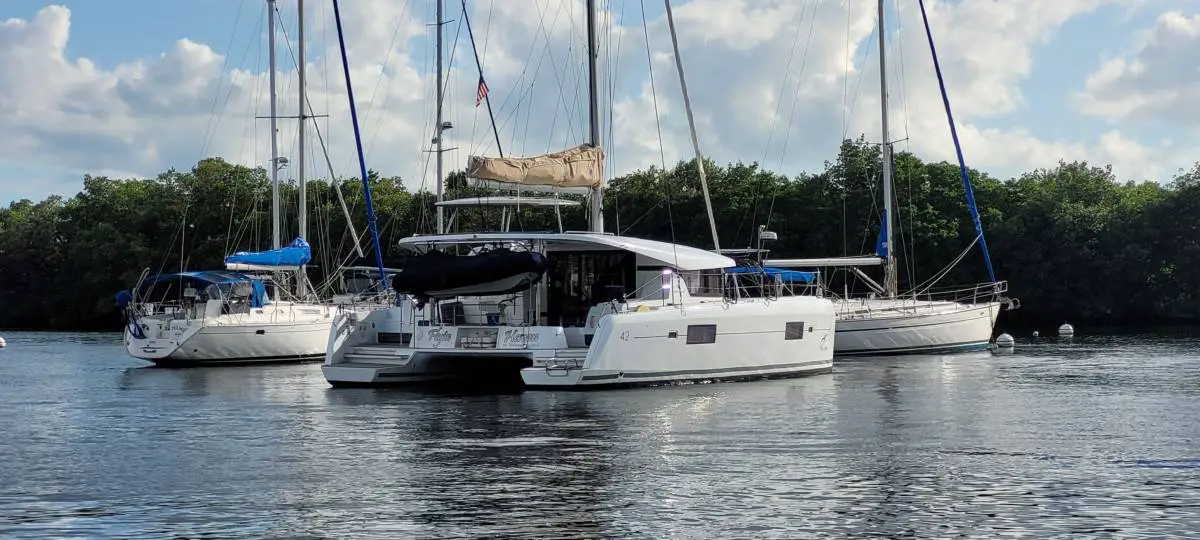
As an Amazon Associate, we earn from qualifying purchases. We may also earn commissions if you purchase products from other retailers after clicking on a link from our site.
Solar panels have become game changers when it comes to supplying power while off the grid. Marine solar panels can charge anything from batteries to computers to bigger electronic appliances. What are the best solar panels for sailboats?
The 9 best solar panels for sailboats are:
- Renogy Flexible Solar Panel
- Newpowa Solar Panel
- SunPower Flexible Sol ar Panel
- Eco-Worthy Off-Grid Solar Panel
- Rich Solar Polycrystalline
- Topsolar Flexible Solar Panel
- HQST Monocrystalline Solar Panel
- WindyNation Solar Panel Complete Off-Grid
- DOKIO Solar Panel Kit
This article will explore everything you need to know about the best marine solar panels.
Table of Contents
Solar Panels on Sailboats: An Overview
Before exploring the best solar panels, it is helpful to consider how solar panels on sailboats work and how many you need. Solar panels sit on different parts of a sailboat’s surface and absorb the sun’s rays, converting them into energy. This energy is used to power chargers, fridges, cooking stoves, and other electronics you need for self-sufficient sailing.
Worth noting is that today we will only discuss solar panels and not the batteries, which of course is an essential part of a complete system; we will also not discuss charges or charge controllers.
The products in this post will get you started in the right direction, but if you’re looking for a high-output system, then I suggest you contact someone that can help you calculate your energy requirements.
How Many Solar Panels Do I Need for My Sailboat?
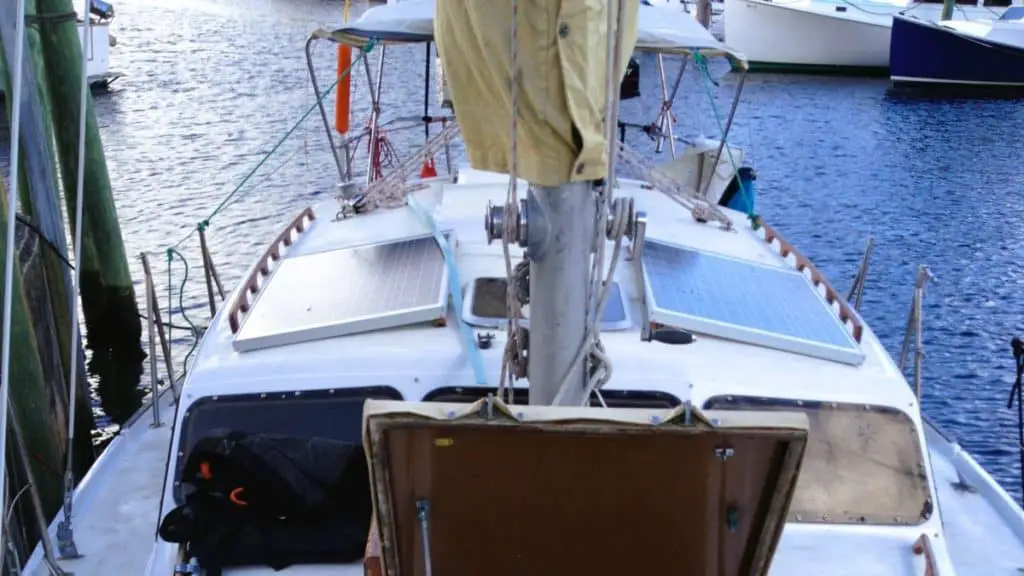
You will need between 2-8 solar panels for your sailboat. The exact amount depends on your sailboat’s space and how many electronics you need to power. Most solar panels can absorb between 100-300 watts per hour. On average, you will need approximately 1500 watts of power each day.
If your solar panels absorb 1500 watts daily, here’s what they can power on your sailboat:
- A laptop charger
- A microwave
- A coffee maker
- An induction cooker
If you want to power more heavy-duty electronics like a washing machine or a television, look for solar panels that absorb 400 watts. For heavy-duty electronics, try installing 5-8 solar panels.
Flexible vs. Rigid Solar Panels
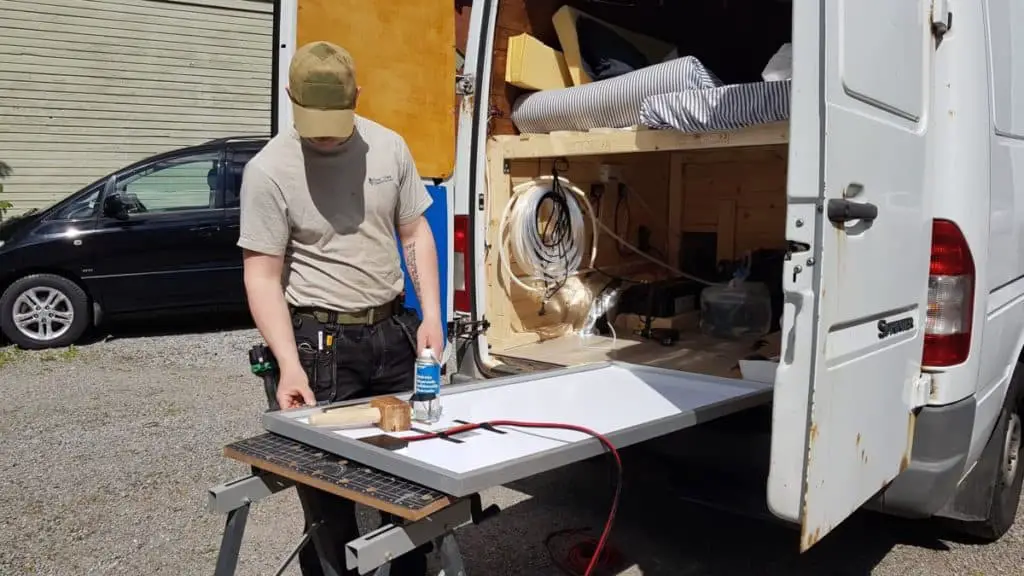
The three main types of solar panels are rigid panels, flexible panels, and semi-flexible panels.
Rigid panels are surrounded by aluminum and made with sturdy tempered glass. They are resilient against various weather conditions but require flat space to install.
Semi-flexible panels can be slightly bent to fit the shape of the installation surface. However, they can’t absorb a lot of power.
One very common type of solar panel used on boats is the flexible panel . Flexible panels are thin and lightweight, and, as their name suggests, they can be added to a wide variety of surfaces.
Here are the pros of flexible panels:
- They are thin and light. Flexible panels are approximately one-eighth the weight and size of rigid and semi-flexible panels. This allows you to add them to various sailboat sizes and surfaces. It also reduces the load on your sailboat.
- They are easy to install. Flexible panels are easy to work with and can be self-installed by following the instructions that come with the panels. Meanwhile, rigid and semi-flexible panels may require expert installations.
- They’re sturdy. Despite being light, flexible panels can bear a lot of pressure – you can easily walk over them.
However, there are also some drawbacks to using flexible solar panels:
- May fly away . As flexible panels are fragile, they can easily be dislodged and fly away, especially in strong winds.
- Vulnerable to scratches . While flexible panels can bear much weight, they may get scratched more easily. Over time this may affect their functionality.
- Not easy to reposition. Flexible panels are generally adhered to the surface of a sailboat using a specially prepared adhesive. Because of this, it is challenging to reposition the solar panels when there is a change of season.
- Less efficient. Flexible solar panels don’t convert energy to electricity or rigid panels. It may be harder to power heavy-duty appliances from a flexible solar panel.
How Many Panels Can I Fit on a Sailboat (Catamaran and Monohull)?
The amount of panels you can fit on your sailboat depends on the size of the panels and the surface space you have available.
You can fit at least two 400W panels on a Monohull and at least four on a Catamaran around 35ft in length. You will be able to fit 4-8 more solar panels if you add a solar panel bracket at the stern.
Renogy Flexible Solar Panel 100W
Renogy is a popular solar panel producer that designs high-quality solar panels. The Renogy Flexible Solar Panel is specially designed for marine vehicles, including sailboats.
Here are the best features of this solar panel:
- Flexibility . These solar panels are fragile, making them flexible and easy to mount on served surfaces.
- Easy to install. These are made with high-quality Monocrystalline, allowing them to be easily bent and easy to install.
- Lightweight. One solar panel weighs only 4 pounds, ensuring that no extra pressure or weight is displaced on your boat.
- Durability . User reviews have noted that these panels are highly durable and can last you a few years.
- Users have noted that these panels do not have the best outputs. They also can’t be stacked, which impacts their accessibility. To ensure that these panels can be connected, you may purchase extra extension cords.
Newpowa Rigid 160W Solar Panel
The Newpowa Right Solar Panel is a new design with a maximum power of 160W. It is weather-resistant and can be used on various surfaces and vehicles.
Here are the pros of the Newpowa Solar Panel:
- Weatherproof . The design features of this solar panel ensure that it survives under a range of different weather conditions. It has a heavy-duty frame preventing it from strong wind and waves. Its mainframe has a further layer of protection for the Junction box.
- Long warranty . Newpowa offers a 25-year transferrable output power warranty.
- Easy to install . These solar panels are made with mono cells and bypass diodes. Consequently, the solar panels can be immediately unpacked and are ready to install.
- High wattage. As these solar panels have 160 Watts of power, you need less of them to power all the devices on your boat.
- If you are planning on buying the Newpowa Solar Panel, you should note that they only make rigid panels. As a result, you may find it to be difficult to install them on curved spaces.
SunPower 110W Flexible Solar Panel
SunPower’s Flexible Solar Panels are made with high-quality materials ensuring durability. They are especially ideal for sailboats as their warranty also covers saltwater damage.
Here are the standout features of the SunPower 110W Flexible Solar Panel:
- Flexibility . This solar panel can be bent up to 30 degrees, making it easy to install on various surfaces.
- Easily portable. These solar panels are incredibly lightweight (4.4 pounds or 2 kilograms) and can be easily uninstalled and transported.
- Extended warranty . SunPower offers a five-year warranty on power and a two-year warranty on the product. The warranty includes damage caused by saltwater which many other solar panel warranties do not.
- Some users have noted that the output quality of these solar panels deteriorates over time. However, you can use the extended warranty to address any quality deterioration.
ECO-WORTHY Rigid 25W Off-Grid Solar Panel
This is a rigid, 25-watt solar panel that is waterproof, making it ideal for your boat. It is highly durable and has inbuilt indicators that highlight the battery’s status. Its low output makes it only suitable for charging phones or smaller electronics.
Here are some notable features of the Eco-Worthy Solar Panel:
- Ease of use. This solar panel is easy to install and requires no maintenance.
- Warranty. Eco-Worthy offers one year of warranty on all of its products and free maintenance if needed.
- USB control. This solar panel is attached to a USB control panel, preventing it from overcharging and getting damaged.
- Waterproof. All solar panel parts are entirely waterproof and can handle exposure to both saltwater and freshwater.
Some of the drawbacks to this solar panel include:
- Low watt absorption. Unlike many of the other solar panels on this list, this one can only absorb up to 25 watts of power at a time. So, it can only power smaller devices like batteries.
- Instruction manual. Some users have noted that the instructions to set up the Eco-worth solar panel are confusing for beginners. If you have never installed solar panels before, it’s best to call in an expert to help.
RICH SOLAR 100W Rigid 12V Polycrystalline
This 100W rigid solar panel is designed to absorb energy even in low light conditions. It is easy to install and ideal for marine environments.
Here’s why you should consider buying Rich Solar Panels:
- Works well in low light. This solar panel has been tested in various low light conditions, including cloudiness and during sunrise and sunset. It is certified to be able to harvest energy in low light conditions.
- Extended warranty. Rich Solar Panels offers a 25-year warranty on limited power output and a five-year warranty on quality.
- Water and weatherproof . The Rich Solar panels have used selective design elements to ensure they are water-resistant. They have high transparency and are made with tempered glass to withstand high winds and water pressure.
- Cost-effective . These are significantly cost-effective, making it easy to equip your sailboat fully.
- While solar panels can easily resist strong winds and water, they can be vulnerable to hail. Hail storms can cause dents on the solar panels, which can eventually cause damage.

Topsolar Flexible 100W Solar Panel
Topsolar provides premium flexible solar panels that are easy to move and install. They are ideal for installing on water vessels like sailboats with waterproof materials.
Here are some of the pros of choosing the Topsolar Flexible Solar Panel:
- Flexibility . The arc radius of this solar panel is 16 inches (40 centimeters) and can be bent to fit several curved surfaces allowing your solar panel to harvest the most sun.
- Efficiency . These solar panels are made with ETFE (ethylene tetrafluoroethylene) materials. They are extremely energy efficient and can rapidly convert energy.
- Some users have noted that these solar panels don’t have as long a life as other panels. In addition, some panels may only be able to absorb up to 75 watts of power at a time.
HQST Rigid 100w Monocrystalline Solar Panel
This is a 100-watt solar panel that has been specially designed to perform well in low light. It is made with high-quality materials and is ideal for sailing boats as it is durable even in unfavorable weather conditions.
Here are the pros of installing the HQST Solar Panel:
- Durability . These solar panels are designed to withstand strong winds and snowfall. They’re made with tempered glass and aluminum and are resistant to corrosion, ensuring longevity.
- Testing and warranty. Each solar panel is quality tested before it is distributed. It also comes with a three-year warranty.
- Easy to install . While these are rigid solar panels, they have pre-drilled holes, making them easier to install.
WindyNation 100W Solar Panel Complete Off-Grid
As its name suggests, this solar panel is designed for off-the-grid living and is helpful if you need to access power when you’re in the middle of the sea.
Here is why you should consider the WindyNation Solar Panel:
- Includes a charge controller. This controller lets you quickly see the amount of power the solar panel has absorbed.
- High power. Several positive user reviews have indicated that this solar panel is highly efficient in absorbing and converting power.
- This solar panel is more expensive than many others on the market.
DOKIO 300W 18V Portable Solar Panel Kit
If you are looking for a heavy-duty solar panel, the Dokio Solar Panel Kit is excellent. It can absorb a lot of energy and power a wide range of appliances on your sailboat.
Here’s why you should consider this solar panel:
- Versatile and flexible. While this is a rigid solar panel, it can be folded, making it easy to transport and install.
- High efficiency. This solar panel is highly efficient at converting energy into power. As it absorbs up to 300 watts, you can install just two of these panels to get significant energy.
- Some users have noted that this solar panel does not work well in low-light conditions. You may want to have a backup solar panel for days when it’s rainy and windy.
Here are Some of My Favorite Catamaran Cruising Resources
Thank you for reading this article. I hope you found it helpful as you hopefully start your sailing adventures. Here are some resources that I use as a sailor that I hope you’ll also find helpful. These are affiliate links, so if you do decide to use any of them, I’ll earn a commission. But in all honesty, these are the exact things that I use and recommend to everyone, even my own family. Sailboats: If you’re looking for the best boat to suit your needs, I would recommend a catamaran. If you’re interested, I can show you the differences between catamarans and other types of sailboats .
Books: For getting started, I really like Cruising catamarans made easy . It is actually a textbook from the American sailing association; it is used to get a cruising catamaran certification. There are some other great books, and I have compiled a list of books about cruising catamarans that you will find useful.
Communication: Being out on adventures, whether it be sailing or climbing mountains, good communications are essential to being safe. I recommend two things Google fi (incredibly simple cellular data all over the world) and Garmin inreach mini (for text and voice in remote areas without cell coverage)
Sailing courses: Online sailing courses are great for beginners starting out their sailing career; it’s an efficient way of learning the basics of navigation, throttle controls, and maritime safety. I suggest starting with two free courses from NauticEd .
To see all my most up-to-date recommendations, check out this resource that I made for you!
Owner of CatamaranFreedom.com. A minimalist that has lived in a caravan in Sweden, 35ft Monohull in the Bahamas, and right now in his self-built Van. He just started the next adventure, to circumnavigate the world on a Catamaran!
Leave a Reply Cancel reply
Your email address will not be published. Required fields are marked *
Save my name and email in this browser for the next time I comment.
Recent Posts
Must-Have Boat Gear for Catamaran Sailors!
Sailing is probably the most gear-intensive activity I've ever done; there are so many decisions to be made about what gear to buy now, for tomorrow, and what to definitely never buy. The gear on...
6 Best Trailerable Trimarans For Bluewater and Coastal Sailing
Having a boat costs a lot of money, even when you are not using it, marina fees, etc. And once it is in the water most sailors never go very far from their "home marina" and sailing will be somewhat...

Service Locator
- Angler Endorsement
- Boat Towing Coverage
- Mechanical Breakdown
- Insurance Requirements in Mexico
- Agreed Hull Value
- Actual Cash Value
- Liability Only
- Insurance Payment Options
- Claims Information
- Towing Service Agreement
- Membership Plans
- Boat Show Tickets
- BoatUS Boats For Sale
- Membership Payment Options
- Consumer Affairs
- Boat Documentation Requirements
- Installation Instructions
- Shipping & Handling Information
- Contact Boat Lettering
- End User Agreement
- Frequently Asked Questions
- Vessel Documentation
- BoatUS Foundation
- Government Affairs
- Powercruisers
- Buying & Selling Advice
- Maintenance
- Tow Vehicles
- Make & Create
- Makeovers & Refitting
- Accessories
- Electronics
- Skills, Tips, Tools
- Spring Preparation
- Winterization
- Boaters’ Rights
- Environment & Clean Water
- Boat Safety
- Navigational Hazards
- Personal Safety
- Batteries & Onboard Power
- Motors, Engines, Propulsion
- Best Day on the Water
- Books & Movies
- Communication & Etiquette
- Contests & Sweepstakes
- Colleges & Tech Schools
- Food, Drink, Entertainment
- New To Boating
- Travel & Destinations
- Watersports
- Anchors & Anchoring
- Boat Handling
What You Need To Know About Boat Solar Panels
Advertisement
Sunshine and boats are a natural together, so why not use all that free energy? Here’s the lowdown on solar panel selection and installation
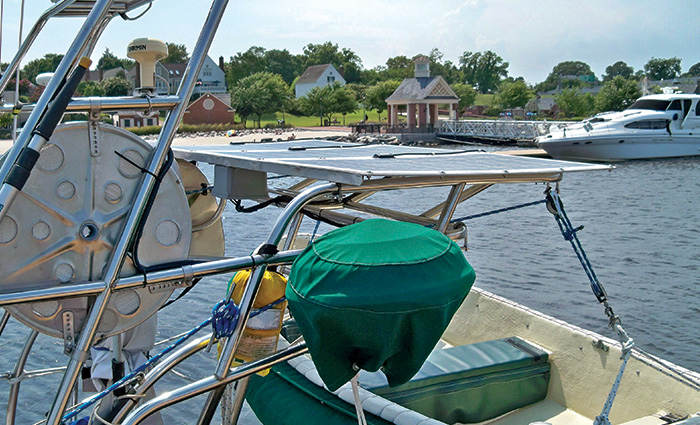
I first embraced the idea of solar power while up a pole (literally) in the Atlantic Intracoastal Waterway replacing dead batteries. It was the early 1980s, and I was maintaining buoys, beacons, and other such Aids To Navigation (ATON) for the U.S. Coast Guard, replacing massive, nonrechargeable batteries with rechargeable solar-powered ones. The higher-ups said the solar rechargeables would last six years – twice as long as the one-shot batteries. As the deck-ape in charge of lugging all those batteries up and down the ladders, my back and I immediately appreciated the whole “free power from the sun” thing, a concept I continue to embrace.
The strategy behind s olar energy onboard is simple: A solar panel converts sunlight into electricity, after which wiring conducts it to your batteries for storage until needed. Solar panels are used to keep batteries or banks charged rather than to power equipment directly. This arrangement allows the panels to store generated power whenever produced, while providing a steady source of power to a piece of equipment even when the panel is producing no power.
While they do require an initial outlay, solar panels can easily pay for themselves in money saved and independence gained over their service life. They’re noiseless, have no moving parts, and they provide free electricity for years with minimal maintenance. Solar panels also have the benefit of being modular, letting you start small and add more as your power requirements increase.
The benefits of solar
Almost any boat can benefit from solar power. Whether at a slip, mooring, or on a trailer, boats can keep their batteries topped off without the need for external power. You can also use solar power to supplement or even replace other onboard charging sources, reducing or eliminating the need to run engines or generators to keep batteries topped off (a wasteful practice that burns fuel while wearing down the costliest pieces of equipment onboard).
While underway, it’s a plus to be able to recharge a dead battery in an emergency – say, to operate a VHF radio or navigation gear. While dockside, solar panels keep batteries charged and vital systems (such as bilge pumps) up and running without the need for shore power.
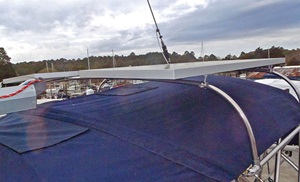
Just about any boat can benefit from solar power, whether it’s to keep batteries topped off or supplement other onboard charging sources.
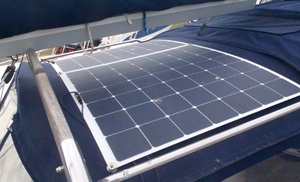
Mount solar panels where they are exposed to maximum sunlight but do not interfere with operation of the vessel.
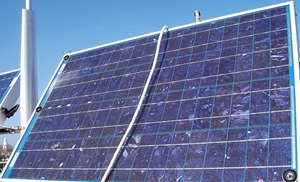
Bottom: Something as simple as the shadow of a line or shroud can reduce or halt output.
Types of panels
Solar panels contain photovoltaic cells – small silicon semiconductor devices that convert sunlight into electricity. Each cell generates between 0.45 and 0.5 volts, depending on exposure to direct sunlight. Cell size determines amperage, with a 3-inch cell producing roughly 2 amps, a 4-inch cell a little over 3 amps, and a 5-inch cell around 5 amps.
Construction-wise, the three main types of solar panels are monocrystalline, polycrystalline, and amorphous (or thin-film) technology.
Monocrystalline panels have been around the longest and remain the most popular. The panels are constructed of thin slices of crystal silicon (each cell is cut from a single crystal) housed in a rigid, aluminum frame and covered with tempered shatterproof glass. The panels have a uniform black, blue, or gray appearance and are generally quite rugged, although they can be cracked or broken if subjected to extreme abuse.
Monocrystalline panels have the longest service life of the three types. With a conversion efficiency of around 17%, they’re also the most efficient and have the highest electrical output per area, but they are also the most expensive.
Polycrystalline cells are sliced from a cast silicon block and have a shattered glass appearance. Built in much the same way as monocrystalline panels, they’re rectangular, giving the panel itself a tiled look. Their life span is similar to monocrystalline panels, and while their conversion efficiency is lower (by 14%), they’re also a bit less expensive.
Amorphous panels are made by placing a thin film of active silicon on a solid or flexible backing (such as stainless or aluminum sheeting) depending on whether the panel is to be rigid-framed and glass-fronted or flexible. Flexible amorphous panels, in which cells are sandwiched between rubber and polymer covers, are light and tough enough that you can walk on them and, in some cases, even roll them up for storage.
This type of solar panel is also better if shade is an issue. With crystalline panels, even the thin shadow of a rope or shroud across one cell can reduce or halt output of an entire module. Amorphous panels have “bypass” diodes that essentially turn off shaded cells and provide a current path around them. Some monocrystalline panels also have bypass diodes, but this feature comes at an increase in cost.
Amorphous panels are the least expensive of the three types, but their efficiency is also lower – around 8%, or roughly half that of a monocrystalline type. This lower output is somewhat mitigated in newer panels, however, which use three-layer construction. Each layer absorbs different colors of the solar spectrum, so the panel will deliver more power longer each day and during lower light conditions than the other two types.
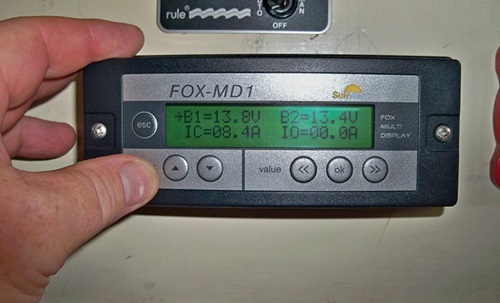
The charge controller should be mounted below decks and as close to the battery as possible.
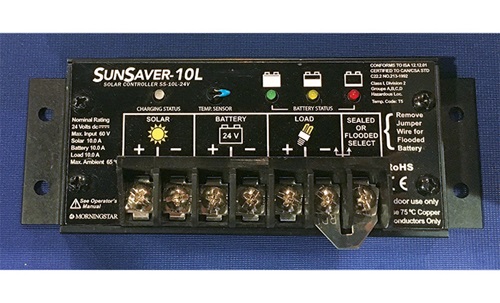
Follow manufacturer instructions for wire connections.
Planning the system
While factors such as cost, mounting options, and output are important, a successful installation depends on knowing what you want the system to accomplish. Is the goal to float-charge a single battery or supplement an overall vessel energy plan? Answering these questions up front will help determine the type, size, and number of panels required.
To understand the process better, let’s walk through the basic steps to determine power requirements and installation considerations for a single solar panel installation. While the example itself is simple, the steps are the same used to plan more complicated installations.
For our example, the goal is to install a solar panel to provide charging for a single 12-volt, 100-amp-hour wet-cell battery used to power an automatic anchor light on a moored vessel.
The first step is compiling a daily power consumption estimate to determine how much solar power is needed.
The daily self-discharge rate for a wet-cell battery is roughly 1%, meaning our 100-amp-hour battery requires one amp every 24 hours just to maintain the status quo. The anchor light draws 50 milliamps per hour of operation, and we’ll assume it operates 10 hours each night. Multiplying current draw (50 milliamps) by hours of daily operation (10) generates a daily energy expense of 500 milliamps or .5 amps.
This means our solar panel must meet a minimum daily energy tab of 1.5 amps – one amp of battery self-discharge rate plus .5 amps of power draw for the anchor light.
Next up is figuring out panel size and the best mounting location. For our example, let’s assume the panel will be a horizontal, fixed-mount installation. A 10-watt horizontally mounted panel should generate between 3- and 5-amp hours per day.
We’ll need at least 13 volts to fully charge our 12-volt battery. As most solar cells generate at least 0.45 volts, you’ll want a panel with a minimum of 33 cells, which should provide around 14.85 volts.
Keep in mind that’s the minimum needed, which may not be enough once you factor in a few cloudy days. Most panels are designed to generate between 15 and 20 volts to overcome problems like cloudy days or inherent electrical resistance within the panel or installation components. While this higher voltage lets you make up for less electrically productive days, it also means you’ll want to install a solar charge controller (voltage regulator) to avoid battery damage due to overcharging.
Attempts to plan a system that tries to use the output of the panel and capacity of the battery to prevent overcharging (and avoid the installation of a charge controller) is false economy and should not be done. The system will never meet its full output potential and, worst case, can damage the battery due to overcharging.
A word on ‘charge controller confliction’
If your vessel has multiple charging sources, such as solar panels and a wind turbine, a crucial but often overlooked consideration is “charge controller confliction.” In short, this is an issue where the charge controller for your solar panel and the charge controller for your wind turbine are internally adjusted to the same maximum charge voltage set point. This means they are constantly fighting each other to be the dominant power source, which results in diminished overall charging output and performance. An in-depth article on this issue can be found at missioncriticalenergy.com (in the website footer, click “Superwind Turbine Manuals & Technical Bulletins.” Under the header “Charge Controllers,” select the document “Resolving Charge Controller Confliction”).
While this article addresses charge controller confliction at remote, off-grid sites, the information provided is also applicable to vessel installations. — F.L.
Location and mounting
Solar panels should be mounted in a location where they are exposed to the maximum amount of sunlight but do not interfere with operation of the vessel or the movement of passengers and crew. Solar panels will typically be either fixed or mounted on some type of movable bracket that allows you to actively point the panel toward the sun for maximum output. Both methods have their pros and cons. Fixed panels (which are normally mounted horizontally) don’t produce as much power as a panel that can be adjusted to face the sun. The downside is that adjustable panels must be aimed throughout the day to maximize their output.
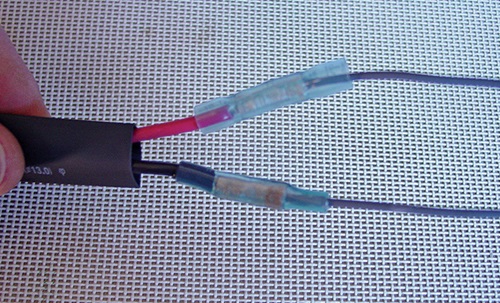
Use good quality, marine-grade heat shrink connectors (top) and liquid electrical tape (right) to create airtight, waterproof seals and reduce corrosion.
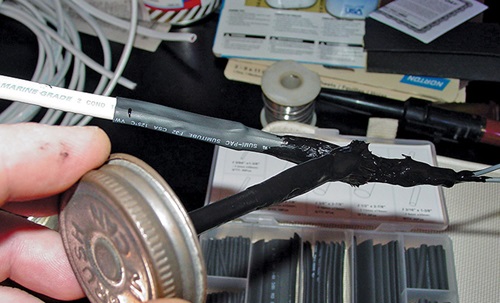
Installation
After choosing and mounting your panel, it’s time to connect it. The first thing you need to determine is the size (gauge) of the wiring to be used. Multiply your panel’s rated amp output by 1.25 (which adds a 25% safety factor). Then measure the length of the entire wiring run, panel to battery, and multiply by 2. Once you have these two numbers, refer to the American Boat and Yacht Council’s (ABYC) 3% voltage-drop table for wire size. Ancor Products offers a handy wire calculator on its website ( ancorproducts.com/resources ).
Always use good quality marine grade connectors and tinned, multi-stranded copper wire with vinyl sheathing. The wire will run from the solar panel to the charge controller first, then to the battery. Try to keep the wire run as short as possible, and if it transits an external deck or cabin house (it likely will), be sure to use an appropriate weatherproof deck fitting.
The charge controller should be mounted below decks and as close to the battery as possible. You’ll always want to follow the manufacturer’s instructions for connections, but in a typical installation you’ll connect the solar panel’s positive (red wire) lead to the charge controller’s positive input wire or terminal and the negative (black wire) lead to the charge controller’s negative input wire or terminal.
Next, connect the charge controller’s negative output to the battery negative terminal and the controller’s positive output to the battery’s positive terminal via an appropriately sized in-line fuse (or circuit breaker). ABYC recommends these be installed within 7 inches of connection to the battery or other point in the DC system. To reiterate, the installation of the charge controller can vary among models, so follow the manufacturer’s installation instructions.
Finally, ensure all connections are waterproof and secure any loose wire runs with wire ties and cable clamps for a neat installation. Then get ready to lean back and soak up some free sun.
Related Articles
The truth about ceramic coatings for boats.
Our editor investigates the marketing claims of consumer-grade ceramic coatings.
Fine-Tune Your Side Scan Fishfinder
Take your side-scanning fishfinder off auto mode, and you’ll be spotting your prey from afar in no time
DIY Boat Foam Decking
Closed-cell foam flooring helps make boating more comfortable. Here’s how to install it on your vessel
Click to explore related articles
Frank Lanier
Contributing Editor, BoatUS Magazine
Capt. Frank Lanier is a SAMS Accredited Marine Surveyor with more than 40 years of experience in the marine and diving industries. He’s also an author, public speaker, and multiple award-winning journalist whose articles on boat maintenance, repair, and seamanship appear regularly in numerous marine publications worldwide. He can be reached via his YouTube channel “Everything Boats with Capt. Frank Lanier” and website captfklanier.com.
BoatUS Magazine Is A Benefit Of BoatUS Membership
Membership Benefits Include:
Subscription to the print version of BoatUS Magazine
4% back on purchases from West Marine stores or online at WestMarine.com
Discounts on fuel, transient slips, repairs and more at over 1,200 businesses
Deals on cruises, charters, car rentals, hotel stays and more…
All for only $25/year!
We use cookies to enhance your visit to our website and to improve your experience. By continuing to use our website, you’re agreeing to our cookie policy.

IMAGES
COMMENTS
Getting Started with Sailboat Solar. Sunpower Solar Panels are considered by most in the industry as the gold standard. They use the highest-efficiency solar cells and have top-notch build quality. In this simple installation, three 50w panels are just enough to get you started. Plus, it’s the most affordable installation! 150w Starter Solar ...
The 9 best solar panels for sailboats are: Renogy Flexible Solar Panel. Newpowa Solar Panel. SunPower Flexible Solar Panel. Eco-Worthy Off-Grid Solar Panel. Rich Solar Polycrystalline. Topsolar Flexible Solar Panel. HQST Monocrystalline Solar Panel. WindyNation Solar Panel Complete Off-Grid. DOKIO Solar Panel Kit.
April 13, 2022. Table of Contents. Table of contents. The Benefits of Installing Solar Panels on a Sailboat. What Kind of Solar Panels Are Best for Sailboats? How Many Solar Panels Do You Need for Your Sailboat? Mounting Your Solar Panels. Installing Your Sailboat Solar Panels. Should You DIY or Hire a Professional for This Job?
A 10-watt horizontally mounted panel should generate between 3- and 5-amp hours per day. We’ll need at least 13 volts to fully charge our 12-volt battery. As most solar cells generate at least 0.45 volts, you’ll want a panel with a minimum of 33 cells, which should provide around 14.85 volts.
Marine solar panels are an excellent source of electrical power for the cruising sailboat or power boat (or camper van or houseboat or RV). We at Custom Marine Products have developed numerous approaches to installing marine solar systems easily and cost effectively.